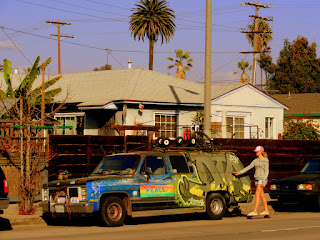 In this map (courtesy of ppic.org), the percent of voters for Obama in 2008 are shown by region, with the region's size shown by population not by actual size
In this map (courtesy of ppic.org), the percent of voters for Obama in 2008 are shown by region, with the region's size shown by population not by actual sizeCalifornia is seen as a strong liberal / Democratic Party haven. While this is true, a look closer reveals some very complicated realities. This can explain why same-sex marriage, legalized marijuana, and GMO labeling have all failed in this supposedly very liberal state.
My thesis:
California's "bipolar" or "schizophrenic" political nature is the product of its overwhelming diversity.
In California, a large segment of the population is either a frst generation immigrant or the child of immigrant(s). Many people retain very traditional cultural and religious beliefs and these are in conflict with newer more liberal social issues such as same-sex marriage, legalization of marijuana, and the natural food movement. Many voters are also older, and tend to have more conservative tendencies and values.
Let's look at these issues one by one.

Same-sex marriage:
Large numbers of adherents to religions with strong traditional beliefs inhabit California. This includes 10 million Catholics and 500,000 Mormons (the most outside of Utah). In addition, people of backgrounds with strong traditional beliefs also make up a large number of California residents including 600,000 Armenians, 1 million Persians, an estimated 250,000 Muslim Americans and 400,000 largely Protestant Koreans. Even the Buddhist community of Los Angeles (40% of all Buddhists in the United States) is largely traditionally-oriented, mostly conservative Theravada Thai, Sri Lankan, Cambodian, and Lao.
Marijuana:
Since most of California's population is Latino, black and Asian, and since Latin America and Asia take a hard stance against drugs, this has translated to a population very mistrustful of marijuana legalization and also sensitive to the effects of drugs on poor communities (of which there are many in California including infamous ones like Richmond/Oakland, and South Central Los Angeles, as well as low-income farm communities in the Great Central Valley) and the ongoing horrors of the Drug Cartel Wars in Mexico and Central America. I realize marijuana shouldn't really be in the same category as crack cocaine but many people still view it with suspicon. Even though it has been legalized in the form of medicinal use, full acceptance in California has been hard to come by.

GMOS:
Ads targeted at Latino and black communities in California worked the angle of depicting Prop 37 as an unecessary "luxury" leading to increased food costs for families already working hard to put food on the table. Growing up in LA public schools, my fellow classmates often jokingly (and sometimes not jokingly) mocked me for getting food at expensive "white person" stores like Whole Foods.
Despite these issues, the Democratic Party has been very successful at reaching people in California on the issues that are independent from their traditions and religions.
Issues such as environmental protection, worker's rights, multi-culturalism, public education and social programs have broad support even when the funding is hard to come by (largely a legacy of upper-middle class tax revolts such as Prop 13 in the 1970s).
This "cherry-picking" of liberal issues vs conservative values gives California an overall confusing political portrait. And personally for me, while I may be frustrated by the outcomes of certain issues, I also recognize and celebrate that California exists as a place of variety, accepting all with arms wide open.
California can look like this:

or this:

or this:

and often looks like this:

And its all part of what comes along with being somewhere that has such diversity in its demographics in addition to its cityscapes and landscapes....; A dense concentration of the most diversity the modern world has ever known.
No comments:
Post a Comment